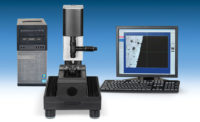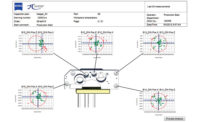ULM/OBERKOCHEN, GERMANY and PEABODY, MA--Carl Zeiss SMT today announced the creation of a technology development project that represents an ambitious electron microscopy development effort. Together with the University of Ulm and CEOS (Heidelberg), Carl Zeiss SMT has initiated a development partnership for low-voltage transmission electron microscopy. A total of 11.5 million Euros are available to the project, which is initially intended to run for a period of five years. The German Research Foundation (DFG) is contributing 4.2 million euros. Carl Zeiss is supporting the project with funds totaling 3.7 million euros.
The joint project goes by the name SALVE, which stands for Sub-Angstrom Low Voltage Electron microscopy. The objective is to develop transmission electron microscopes (TEM) that will image samples with atomic resolution using relatively low accelerating voltage-as compared to the current generation of medium-voltage TEMs that destroy radiation-sensitive samples before useable images can be recorded. The results of this development project will open up many new scientific and technological frontiers. Today, achieving the desired resolution requires special, theoretical correctors that help to correct image aberrations in order to utilize the information of all interacting electrons. Although those correctors have been described theoretically, they do not yet exist.
The pioneer in the theoretical description of such correctors is Professor Harald Rose who previously taught at the technical university in Darmstadt. For him, SALVE means a dream come true to be able to select the accelerating voltage based on the requirements of the sample and the scientific task without sacrificing resolution.
The task of building the correctors has been given to Heidelberg-based CEOS GmbH which specializes in the construction of such sub-systems. CEOS has already proven its capabilities to develop such advanced electron optical systems in various projects. Teams at the University of Ulm will develop applications and examine methods of specimen preparation parallel to the development of the system at Carl Zeiss.
Project manager Professor Ute Kaiser (University of Ulm) voiced her enthusiasm about the application perspectives at the recent kick-off meeting: “This new high-performance microscope will enable us for the first time to image electron-beam-sensitive samples and monitor molecular processes that contribute to decoding chemical conversions. Knowledge of these processes is vital for many areas of application in materials sciences, biomedical research and in semiconductor technology.”
Dr. Dirk Stenkamp, Member of the Board at Carl Zeiss SMT, emphasized the importance of the development for Germany as a technology center: "Traditionally, Germany has played a leading role in electron microscopy. We are proud that, with its sponsoring decision, the DFG is enhancing this position, thus stimulating many scientific areas of application beyond the development of the system. With more than 160 years of experience in microscopy and more than 60 in electron microscopy, Carl Zeiss is an expert partner and sponsor.”
Get our new eMagazine delivered to your inbox every month.
Stay in the know with Quality’s comprehensive coverage of the manufacturing and metrology industries.
SIGN UP TODAY!Copyright ©2024. All Rights Reserved BNP Media.
Design, CMS, Hosting & Web Development :: ePublishing


